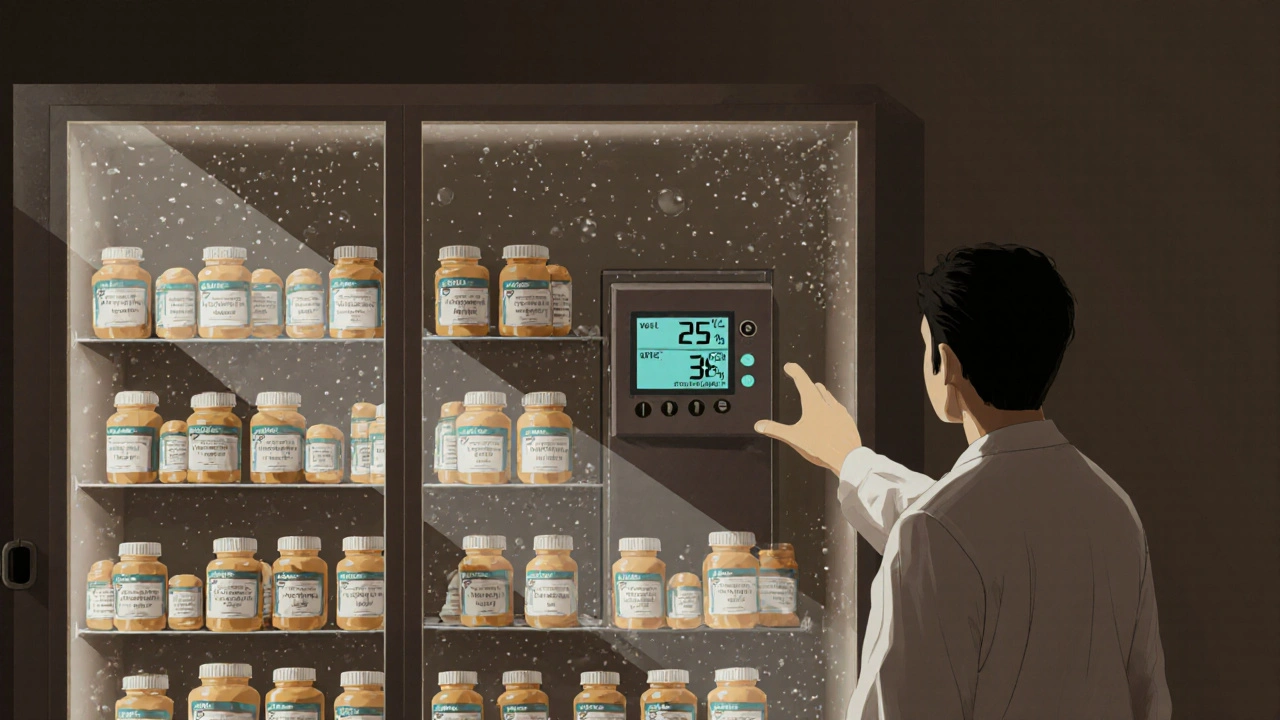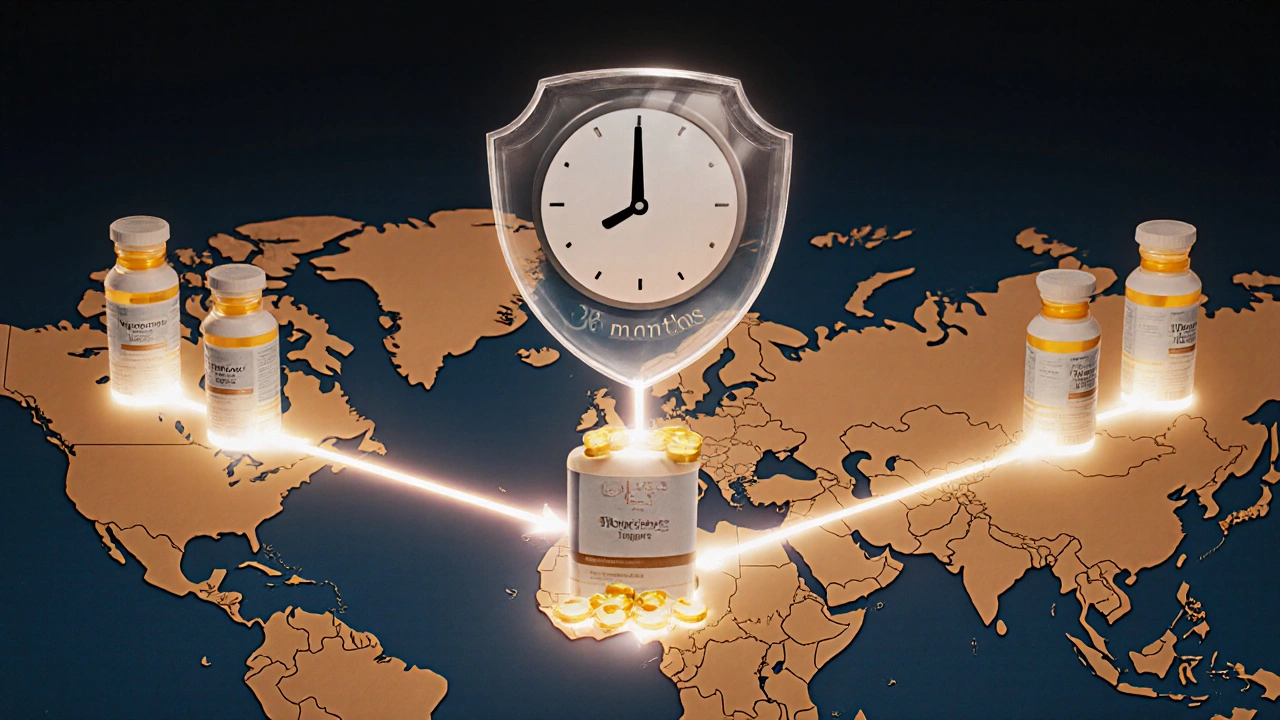Stability Testing: Long-Term Quality Monitoring Post-Manufacture in Pharmaceuticals

Nov, 17 2025
When a pill leaves the factory, it doesn’t stop being monitored. In fact, its real test begins the moment it’s packaged. Stability testing is the quiet, relentless process that ensures a drug doesn’t just sit on a shelf-it stays safe, effective, and unchanged for years. This isn’t guesswork. It’s science, tightly regulated, and absolutely critical to patient safety.
Why Stability Testing Isn’t Optional
Imagine a cancer drug that loses half its potency after six months. Or an antibiotic that turns toxic because of a chemical reaction with its container. These aren’t hypotheticals. In 2021, 17.3% of drug recalls in the U.S. were tied to stability failures-potency loss, degradation products, or container interactions. The FDA doesn’t just ask for stability data; it demands it. Without it, no new drug gets approved. Stability testing answers one simple question: Will this medicine work the same way when the patient takes it, six months or three years from now? The answer determines expiration dates, storage instructions, and even how the drug is packaged. A bottle of insulin needs different conditions than a tablet of metformin. One might need refrigeration; the other just a cool, dry cabinet. Stability testing tells you which.How It Works: The Science Behind the Chambers
It starts in climate-controlled rooms called stability chambers. These aren’t ordinary fridges or closets. They’re precision instruments, calibrated to hold exact temperatures and humidity levels-for example, 25°C and 60% relative humidity for standard long-term testing. For hotter climates, it’s 30°C and 65% RH. Accelerated testing runs at 40°C and 75% RH to speed up degradation, giving early warnings. Samples of the drug are pulled at set intervals: 0, 3, 6, 9, 12, 18, 24, and 36 months. At each point, they’re tested for:- Physical changes: Color, texture, dissolution rate, pH
- Chemical changes: Active ingredient concentration, presence of impurities or breakdown products
- Microbiological safety: Sterility for injectables, bioburden for others
- Photostability: Exposure to light (1.2 million lux hours of visible light, 200 Wh/m² UV) to check for light-induced degradation
The Regulatory Backbone: ICH and FDA Rules
This isn’t company policy. It’s global law. The International Council for Harmonisation (ICH), formed in 1990 by regulators from the U.S., Europe, and Japan, set the standard: ICH Q1A(R2). This document spells out exactly how long to test, under what conditions, and how to analyze the data. The goal? To prove with 95% confidence that 95% of all units in a batch will remain within specifications until the expiration date. That’s not a suggestion-it’s a legal requirement for New Drug Applications (NDAs) and Abbreviated New Drug Applications (ANDAs). The FDA’s 21 CFR 211.192 mandates that every stability failure must be investigated. No exceptions. Even packaging matters. A blister pack might protect a tablet from moisture better than a bottle. Stability testing identifies these interactions. In one 2022 case, a biologic drug was found to degrade when in contact with its rubber stopper. The fix? A different stopper design. The cost of not catching it? Up to $500 million in lost launch revenue.
Costs, Challenges, and Real-World Pain Points
Stability testing isn’t cheap. A single product study can cost $50,000 to $150,000. A mid-sized pharma company might spend $1 million a year just on chambers, testing, and staff. Temperature mapping of each chamber? $8,500 every quarter. Method validation? 3 to 6 months per test. And it’s slow. Real-time testing takes 2 to 3 years. That’s years of product development time tied up. Some companies use accelerated data to predict shelf life-but it’s not foolproof. A 2021 study in the Journal of Pharmaceutical Sciences showed real-time data still outperforms predictions, especially for complex biologics. Then there’s the human factor. A Reddit post from a stability technician in 2023 described a humidity spike that wiped out three months of data. The result? An 8-month delay in an ANDA submission. Cost? $2.3 million in lost market time. One failed chamber. One missed calibration. One delay that cascades.How the Industry Is Adapting
The pressure to cut time and cost is real. That’s why more companies are using ICH Q12, a 2018 guideline that allows for post-approval changes without re-filing. It’s like giving manufacturers flexibility to tweak packaging or manufacturing processes without restarting stability studies from scratch. Quality by Design (QbD) is another game-changer. By understanding how a drug degrades from the start-its chemical vulnerabilities, packaging interactions, and environmental sensitivities-companies can reduce testing needs by 25-35%. One company cut its sample size by 40% and saved $120,000 per product annually. Electronic data systems are replacing paper logs. They cut review time by 55% and reduce human error. But validating these systems? That takes 6 to 9 months.
The Future: AI, Continuous Manufacturing, and Risk-Based Testing
The biggest shift coming? AI. By 2027, machine learning models could predict degradation pathways with 30-40% less testing. Instead of waiting 36 months, companies might use historical data, chemical structure, and environmental inputs to estimate stability in weeks. ICH Q13, finalized in February 2023, is changing how stability is handled for drugs made in continuous manufacturing lines-where product flows nonstop, not in batches. Traditional testing assumed static batches. Now, stability data must reflect real-time production. Some experts, like Dr. Robert Elder, argue that for simple, stable small-molecule drugs, the current 36-month requirement is overkill. He pushes for risk-based testing: less testing for low-risk products, more for complex biologics or unstable compounds. The FDA is listening. Draft guidance in 2023 hints at future flexibility.What Happens When It Fails
A stability failure isn’t just a data point-it’s a crisis. In 2021, a manufacturer ignored out-of-spec results on a cancer drug. The FDA issued a complete response letter. Approval was delayed 14 months. Patients went without. The company lost millions. On the flip side, stability testing has prevented disasters. Between 2020 and 2022, the International Pharmaceutical Aerosol Consortium says 47 dangerous products were blocked from market because stability studies caught unexpected degradation. Dr. Jennifer Orme of Pfizer put it bluntly: “Robust stability programs have reduced post-market recalls by 31% since 2015.” That’s not just compliance. That’s saving lives.Final Thought: It’s Not About Passing a Test
Stability testing isn’t a box to check. It’s a promise-to patients, to regulators, to the public-that what’s on the label is what’s in the bottle, even years later. It’s the reason you can trust a prescription filled in Sydney, Tokyo, or Chicago to work the same way. The numbers are clear: $2.87 billion spent globally in 2022 on stability testing. 100% of FDA-approved drugs since 2010 required it. 18.7% of FDA inspection observations in 2022 were stability-related. This isn’t a cost center. It’s the backbone of pharmaceutical quality. The future won’t eliminate stability testing. It will make it smarter, faster, and more targeted. But the core principle won’t change: Quality doesn’t expire. It must be proven.What is the main purpose of stability testing in pharmaceuticals?
The main purpose is to determine how a drug’s quality changes over time under real-world storage conditions. This data is used to set expiration dates, define proper storage conditions (like temperature and humidity), and ensure the product remains safe, effective, and within regulatory specifications throughout its shelf life.
How long does stability testing usually take?
Real-time stability testing typically lasts 24 to 36 months, with samples tested at intervals like 0, 6, 12, 18, 24, and 36 months. Accelerated testing at higher stress conditions (40°C/75% RH) runs for 6 months to predict long-term behavior, but it doesn’t replace real-time data for final shelf-life determination.
What are the standard conditions for stability testing?
According to ICH Q1A(R2), standard long-term conditions are 25°C ± 2°C and 60% RH ± 5% RH for temperate climates. For hot and humid regions, it’s 30°C ± 2°C and 65% RH ± 5% RH. Accelerated testing uses 40°C ± 2°C and 75% RH ± 5% RH. Photostability requires exposure to 1.2 million lux hours of visible light and 200 watt-hours per square meter of UV light.
Why is stability testing so expensive?
It’s expensive because it requires long-term commitment: specialized climate-controlled chambers, regular calibration, validated analytical methods, trained staff, and massive data management. A single product study can cost $50,000-$150,000. Companies spend $500,000 to $2 million annually on infrastructure. Temperature mapping alone costs $8,500 per chamber every quarter.
Can stability testing be shortened or replaced?
Accelerated testing can give early warnings, but it can’t fully replace real-time data. New approaches like Quality by Design (QbD) and ICH Q12 allow smarter testing with fewer samples. AI and predictive modeling are emerging to reduce timelines by 30-40% by 2027, but regulators still require real-time data for final approval. Risk-based testing is being explored for simple, stable drugs.
What happens if a stability test fails?
A failure triggers an out-of-specification (OOS) investigation under cGMP rules. The company must find the root cause-was it a manufacturing error, packaging flaw, or storage issue? If the problem is confirmed, the batch may be rejected, shelf life shortened, or the product recalled. In severe cases, like a 2021 FDA case, approval can be delayed by over a year.
Do all pharmaceutical companies do stability testing in-house?
No. While the top 50 pharma companies typically run in-house programs, 82% of small biotechs outsource to contract research organizations (CROs) like SGS, Eurofins, or Charles River Laboratories. Outsourcing saves infrastructure costs but requires tight oversight to ensure compliance with ICH and FDA standards.
